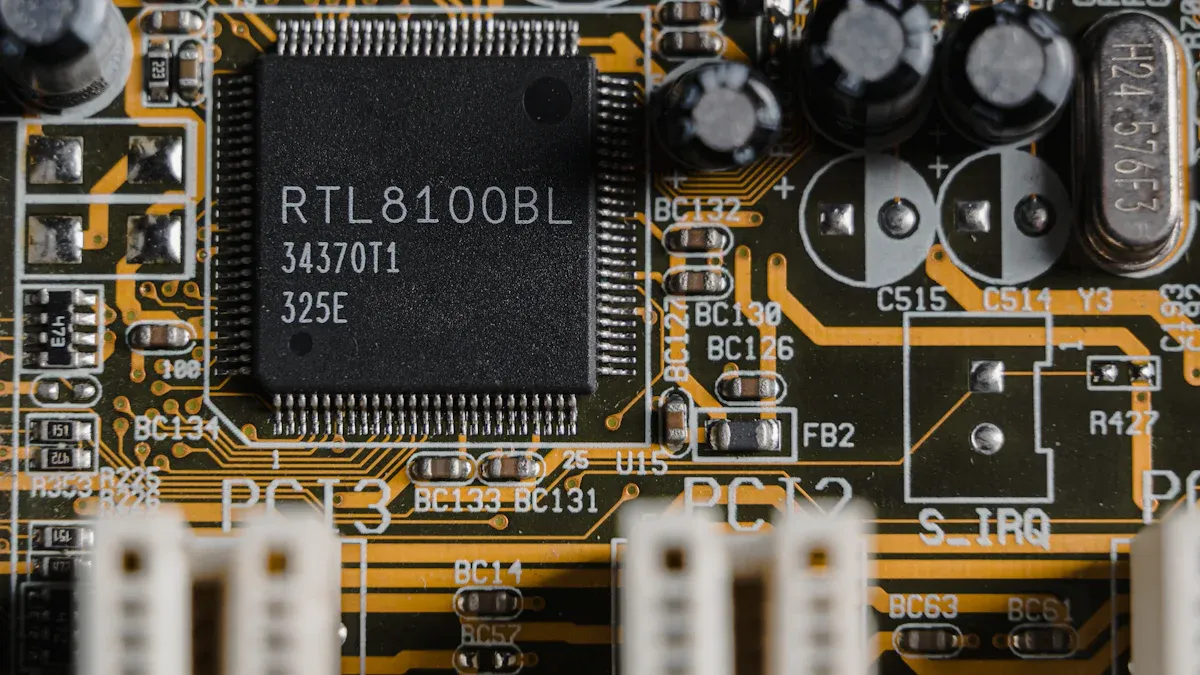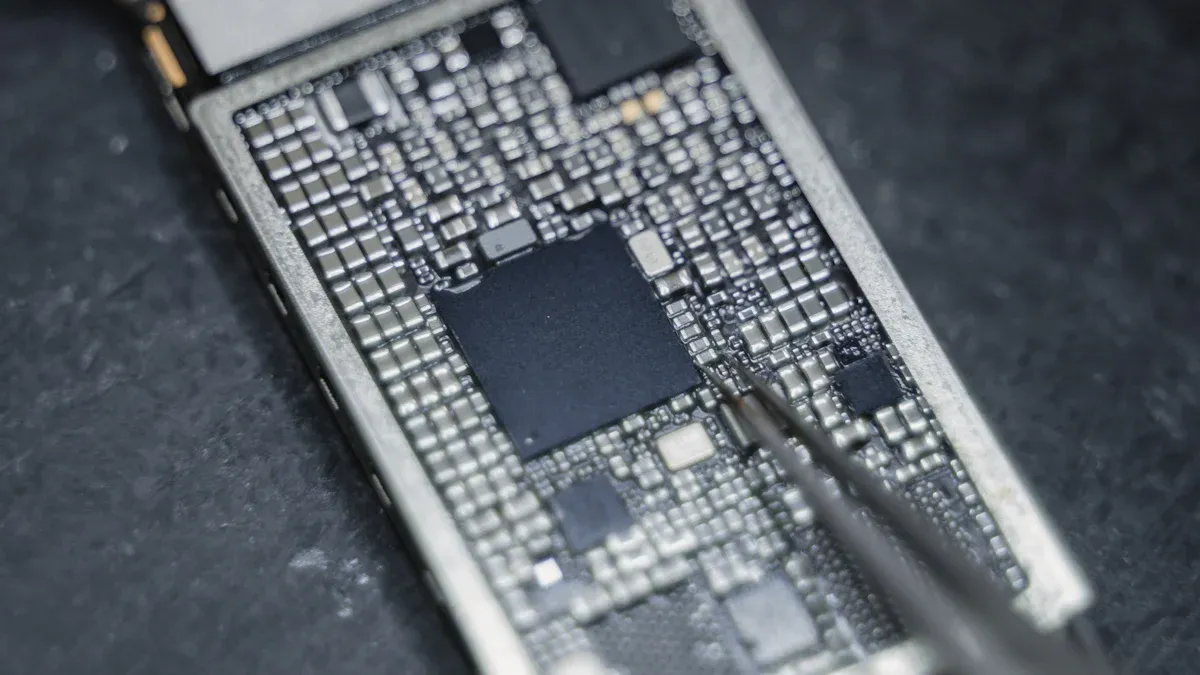How to Choose the Best Step-down IC in SOT-223 Package for Your Project

Efficient power management depends on selecting the right components. Choosing the correct step-down IC SOT-223 ensures stable voltage regulation while minimizing energy loss. This compact step-down IC in a SOT-223 package is widely used in power applications due to its balance of size, thermal performance, and cost.
When evaluating your options, focus on key factors like voltage and current requirements. Assess the step-down IC's efficiency to reduce heat generation. Consider its thermal performance and ensure it fits your PCB layout. These decisions directly impact the reliability and performance of your project.
Key Takeaways
Know your project's voltage and current needs. Pick an IC that fits these to work well.
Focus on efficiency to save energy and reduce heat. Better efficiency keeps small designs cooler.
Check the IC's datasheet closely. It shows important details like limits and PCB tips.
Try the IC in real situations. This checks if it works and keeps your design steady.
Plan for heat control. Use thick copper lines and holes to cool the IC and stop overheating.
Understanding the Step-down IC SOT-223 Package

Overview of the SOT-223 package
The SOT-223 package is a compact surface-mount device widely used in power management applications. Its small size and efficient thermal dissipation make it ideal for step-down ICs. Measuring 6.50 x 7.00 x 1.66 mm, it offers a significant reduction in area and thickness compared to the TO-252 package. This makes it suitable for projects where space is limited.
Feature | SOT-223 Dimensions (mm) | TO-252 Dimensions (mm) | Area Reduction | Thickness Reduction |
|---|---|---|---|---|
Dimensions | 6.50 x 7.00 x 1.66 | 6.60 x 10.00 x 2.30 | 31% | 27% |
Footprint Compatibility | Same as TO-252 | Same as TO-252 | N/A | N/A |
The SOT-223 package also shares footprint compatibility with TO-252, simplifying PCB design and layout adjustments.
Why SOT-223 is ideal for step-down ICs
You’ll find the SOT-223 package ideal for step-down ICs due to its balance of size, thermal performance, and cost. Its compact design minimizes PCB space usage, while its thermal dissipation capabilities ensure stable operation under high power loads. This package supports efficient heat transfer, which reduces the risk of overheating in your circuit.
Another advantage is its compatibility with automated assembly processes. The SOT-223 package works well with standard pick-and-place machines, making it a practical choice for mass production.
Benefits and limitations of SOT-223 for power management
The SOT-223 package offers several benefits for power management. Its small footprint allows you to design compact circuits, while its thermal performance supports reliable operation in demanding environments. Additionally, it provides cost-effective solutions for projects requiring efficient step-down ICs.
However, the SOT-223 package has limitations. Its thermal dissipation, while effective, may not match larger packages like TO-220 in high-power applications. You should carefully evaluate your project’s power requirements to ensure this package meets your needs.
Key Factors for Selecting a Step-down IC SOT-223
Voltage and current requirements
When selecting a step-down IC in a SOT-223 package, understanding your project's voltage and current needs is essential. The input voltage must align with the power source, while the output voltage should match the requirements of your load. For instance, if your input voltage ranges from 4.4V to 12V and your output voltage is 3.3V, you need an IC that can handle these parameters. Additionally, the maximum output current should meet or exceed the current demand of your circuit.
Parameter | Value |
|---|---|
Input Voltage | 4.4V - 12V |
Output Voltage | 3.3V |
Max. Output Current | 1A |
Package | SOT-223 |
You should always verify these specifications in the IC's datasheet. Choosing an IC with insufficient current capacity can lead to overheating or failure. On the other hand, selecting one with excessive capacity may increase costs unnecessarily.
Efficiency and thermal performance
Efficiency plays a critical role in the performance of a step-down IC SOT-223. Higher efficiency reduces energy loss, which minimizes heat generation. This is particularly important in compact packages like SOT-223, where thermal dissipation is limited compared to larger packages.
To ensure proper thermal performance, look for ICs with built-in thermal protection features. These features prevent damage caused by overheating. Additionally, consider the thermal resistance of the package and the PCB layout. A well-designed layout with adequate thermal vias and copper planes can significantly improve heat dissipation.
Tip: Always test the IC under real operating conditions to evaluate its thermal performance. This helps you identify potential issues before finalizing your design.
Input/output voltage range
The input and output voltage range of a step-down IC determines its compatibility with your power source and load. For example, some ICs in the SOT-223 package support input voltages between 15V and 20V, with output options like 3.3V, 5V, or 12V.
Specification | Details |
|---|---|
Input Voltage Range | |
Output Voltage | 3.3V, 5V, 12V |
You should select an IC that not only meets your current voltage requirements but also provides some flexibility for future upgrades. This ensures your design remains adaptable to changes in power supply or load specifications.
Note: Always check the IC's dropout voltage. This is the minimum difference between input and output voltages required for proper operation. A low dropout voltage improves efficiency and allows the IC to operate with a wider range of input voltages.
Switching frequency considerations
Switching frequency plays a vital role in the performance of a step-down IC SOT-223. It determines how quickly the IC switches between its on and off states during operation. A higher switching frequency allows you to use smaller external components, such as inductors and capacitors, which can save space on your PCB. However, it also increases switching losses, which can reduce efficiency and generate more heat.
When choosing the switching frequency, consider the trade-off between size and efficiency. For applications where space is limited, you might prefer an IC with a higher frequency. On the other hand, if your project prioritizes energy efficiency, a lower switching frequency may be more suitable.
Tip: Check the IC's datasheet for recommended switching frequencies. Manufacturers often provide guidelines to help you balance performance and thermal management.
Some ICs offer adjustable switching frequencies, giving you flexibility to optimize your design. You can set the frequency using external resistors or capacitors. This feature is particularly useful when you need to adapt the IC to different operating conditions.
PCB layout and thermal design
Proper PCB layout and thermal design are essential for ensuring the reliable operation of a step-down IC SOT-223. The compact size of the SOT-223 package makes it sensitive to heat buildup, so you need to focus on efficient heat dissipation.
Start by placing the IC close to the power source and load. This minimizes the length of high-current traces, reducing resistance and voltage drops. Use wide copper traces for these connections to improve current flow and heat dissipation.
Thermal vias are another important feature. These small holes filled with copper connect the top and bottom layers of your PCB, allowing heat to spread more evenly. Place thermal vias directly under the IC's thermal pad to maximize their effectiveness.
Design Element | Purpose | Recommendation |
|---|---|---|
Wide Copper Traces | Reduce resistance and heat | Use traces at least 1mm wide |
Thermal Vias | Improve heat dissipation | Place under the thermal pad |
Ground Plane | Spread heat and reduce noise | Use a large copper area |
Note: Avoid placing sensitive components near the IC. High switching currents can create electromagnetic interference (EMI), which may affect nearby circuits.
Finally, consider adding a heat sink or increasing the copper area around the IC if your design involves high power loads. These measures help prevent overheating and ensure stable operation.
Comparing Popular Step-down ICs in SOT-223 Package

Examples of commonly used ICs
Several step-down ICs in the SOT-223 package are widely recognized for their performance and reliability. Here are some examples:
TLV1117: Known for its thermal resistance of 54°C/W (junction-to-case top) and 5.5 K/W (junction-to-board). Its plastic casing limits heat conduction, but it remains a popular choice for low-power applications.
LM1117: Offers a lower dropout voltage, making it efficient for low-output current scenarios. Its design minimizes quiescent current, which is ideal for battery-powered devices.
Proposed Converter: Features a wider input range and higher efficiency in step-up mode, making it suitable for applications requiring voltage boosting.
These ICs demonstrate versatility across different applications, from compact designs to energy-efficient systems.
Pros and cons of popular models
Each step-down IC in the SOT-223 package has unique advantages and limitations.
TLV1117:
Pros: Excellent thermal resistance and robust load regulation.
Cons: Limited heat conduction due to the plastic casing.
LM1117:
Pros: Low dropout voltage enhances efficiency. Cost-effective for moderate efficiency needs.
Cons: May not perform as well in high-power applications.
Proposed Converter:
Pros: Wider input range and optimized load current. High efficiency in step-up mode.
Cons: Advanced designs may offer better transient response.
Understanding these pros and cons helps you select the right IC for your project’s requirements.
Choosing the right IC for specific applications
Selecting the best step-down IC SOT-223 depends on your application’s needs. For battery-powered devices, the LM1117’s low quiescent current and efficiency make it a strong candidate. If your project involves voltage boosting, the proposed converter’s step-up mode efficiency and input range provide an edge. For general-purpose designs, the TLV1117 offers reliable thermal performance and robust regulation.
To make an informed decision, compare specifications like dropout voltage, thermal resistance, and input/output voltage range. Use the table below to evaluate key metrics:
Specification | Details |
|---|---|
Output Voltage | 3.3V, 5V, 12V |
Dropout Voltage | About 1.2V at full load |
Output Current | Up to 1 amp depending on model |
Line Regulation | Excellent |
Load Regulation | Robust |
Thermal Protection | Built-in to prevent overheating |
Package Types | TO-220, TO-263, SOT-223 |
Input Voltage Range | 15 to 20 volts |
Output Voltage Accuracy | Generally within a few percent |
Transient Response | Good |
Quiescent Current | Low |
By aligning these metrics with your project’s requirements, you can ensure optimal performance and reliability.
Practical Tips for Choosing and Testing Step-down ICs
How to read and interpret datasheets
Datasheets are your primary resource for understanding the capabilities and limitations of a step-down IC SOT-223. Learning how to interpret them ensures you select the right IC for your project.
Start by examining the pinout table. This section describes each pin's function, helping you design accurate connections in your circuit. Next, review the functional block diagram. This diagram illustrates the internal structure of the IC, showing how components like regulators and switches interact.
Pay close attention to the charts provided. These charts often include startup behaviors, efficiency curves, and thermal performance data. For example, a chart might show how the IC handles varying input voltages or load currents.
Look for PCB layout recommendations. These guidelines ensure the IC operates correctly, especially for switching regulators. Following these recommendations minimizes issues like electromagnetic interference (EMI) and heat buildup. Finally, check the errata section. This part lists known issues and updates, which can be critical for avoiding design flaws.
Tip: When reviewing datasheets, focus on specifications like input voltage range, maximum rated voltage, and absolute maximum input voltage. For instance, the SiC45x datasheet specifies an input range of 4.5V–20V, with a maximum rated voltage of 20V and an absolute maximum input voltage of 28V.
Testing ICs for project compatibility
Testing ensures the IC performs as expected in your design. Begin by setting up a test circuit that mimics your project's conditions. Use a power supply to provide the input voltage and connect a load that matches your circuit's current requirements.
Monitor the IC's output voltage and current under different conditions. For example, test the IC at minimum and maximum input voltages to verify its regulation capabilities. Check for stability by observing how the IC responds to sudden changes in load current.
Measure the IC's efficiency using a multimeter or power analyzer. Compare the input and output power to calculate efficiency. Higher efficiency indicates less energy loss and better thermal performance.
Note: Pay attention to thermal behavior during testing. Use a thermal camera or infrared thermometer to monitor the IC's temperature. Excessive heat may indicate poor thermal dissipation or an overloaded circuit.
Ensuring proper thermal management and layout design
Thermal management is crucial for reliable operation. Start by designing a PCB layout that promotes efficient heat dissipation. Place the IC near the power source and load to minimize trace lengths. Use wide copper traces for high-current paths to reduce resistance and heat buildup.
Incorporate thermal vias under the IC's thermal pad. These vias connect the top and bottom PCB layers, spreading heat evenly. Add a ground plane to further improve heat dissipation and reduce noise.
If your design involves high power loads, consider adding a heat sink or increasing the copper area around the IC. These measures help prevent overheating and ensure stable operation.
Tip: Avoid placing sensitive components near the IC. High switching currents can generate electromagnetic interference (EMI), which may affect nearby circuits.
Testing your layout is equally important. Use simulation software to analyze thermal performance before manufacturing the PCB. After assembly, test the circuit under real operating conditions to identify potential issues.
Choosing the right step-down IC in a SOT-223 package ensures your project meets its voltage, current, and thermal needs. Prioritize efficiency to reduce energy loss and heat generation. Focus on cost-effectiveness and compatibility to optimize your design without overspending.
Tip: Always review the datasheet carefully. It provides critical details about the IC's performance and limitations.
Test the IC under real-world conditions to confirm it works as expected. This step helps you avoid potential issues and ensures your design operates reliably. By following these steps, you can confidently select the best IC for your project.
FAQ
What is the main advantage of using a step-down IC in a SOT-223 package?
The SOT-223 package offers compact size and efficient thermal dissipation. It saves PCB space while maintaining reliable performance under moderate power loads. This makes it ideal for applications requiring cost-effective and space-saving solutions.
How do I ensure proper thermal management for a SOT-223 step-down IC?
Use wide copper traces and thermal vias under the IC’s thermal pad. Add a ground plane to spread heat evenly. For high-power designs, consider a heat sink or larger copper areas to prevent overheating.
Can I use a SOT-223 step-down IC for high-power applications?
SOT-223 works well for moderate power loads. For high-power applications, consider larger packages like TO-220 or TO-263. These provide better thermal dissipation and handle higher currents more effectively.
How do I test a step-down IC for compatibility with my project?
Set up a test circuit with your input voltage and load requirements. Measure output voltage, current, and efficiency. Monitor thermal behavior using a thermal camera or infrared thermometer to ensure stable operation.
What should I look for in a step-down IC datasheet?
Focus on input/output voltage range, dropout voltage, efficiency, and thermal resistance. Check for recommended PCB layout guidelines and thermal management tips. Pay attention to charts showing performance under varying conditions.
See Also
Selecting The Ideal Low-Power MCU For Your Application
Understanding The Functionality Of Low Impedance Switch Chips
Exploring Applications Of Single Darlington Transistor ICs
